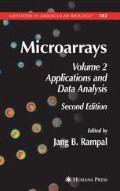Abstract
With the completion of the Human Genome Project, the microarray technology has evolved into a sophisticated platform by which complex diseases such as cancer, can be studied at the genome, transcriptome, and proteome levels. Here, various microarray platforms, namely comparative genomic hybridization, cDNA, oligonucleotide, and protein-based microarrays are exploited to study genomic copy-number changes in a human cancer cell line and correlate these genomic aberrations with their expression at mRNA and protein levels. The protocols described therein can be assimilated for the study of other human tissues including cancerous ones.
Access this chapter
Tax calculation will be finalised at checkout
Purchases are for personal use only
References
Platzer, P., Upender, M. B., Wilson, K., et al. (2002) Silence of chromosomal amplifications in colon cancer. Cancer Res. 62, 1134–1138.
Al-Mulla, F., Al-Maghrebi, M., and Varadharaj, G. (2003) Expressive genomic hybridisation: gene expression profiling at the cytogenetic level. Mol. Pathol. 56, 210–217.
Chung, Y. J., Jonkers, J., Kitson, H., et al. (2004) A whole-genome mouse BAC microarray with 1-Mb resolution for analysis of DNA copy number changes by array comparative genomic hybridization. Genome Res. 14, 188–196.
Pollack, J. R., Perou, C. M., Alizadeh, A. A., et al. (1999) Genome-wide analysis of DNA copy-number changes using cDNA microarrays. Nat. Genet. 23, 41–46.
Brennan, C., Zhang, Y., Leo, C., et al. (2004) High-resolution global profiling of genomic alterations with long oligonucleotide microarray. Cancer Res. 64, 4744–4748.
Johnson, J. M., Edwards, S., Shoemaker, D., and Schadt, E. E. (2005) Dark matter in the genome: evidence of widespread transcription detected by microarray tiling experiments. Trends Genet. 21, 93–102.
Karaman, M. W., Groshen, S., Lee, C. C., Pike, B. L., and Hacia, J. G. (2005) Comparisons of substitution, insertion and deletion probes for resequencing and mutational analysis using oligonucleotide microarrays. Nucleic Acids Res. 33, E33.
Kimura, N., Nagasaka, T., Murakami, J., et al. (2005) Methylation profiles of genes utilizing newly developed CpG island methylation microarray on colorectal cancer patients. Nucleic Acids Res. 33, E46.
Fehlbaum, P., Guihal, C., Bracco, L., and Cochet, O. (2005) A microarray configuration to quantify expression levels and relative abundance of splice variants. Nucleic Acids Res. 33, E47.
Glokler, J. and Angenendt, P. (2003) Protein and antibody microarray technology. J. Chromatogr. B Anal. Technol. Biomed. Life Sci. 797, 229–240.
Quinn, L. A., Moore, G. E., Morgan, R. T., and Woods, L. K. (1979) Cell lines from human colon carcinoma with unusual cell products, double min, and homogeneously staining regions. Cancer Res. 39, 4914–4924.
Auer, H., Lyianarachchi, S., Newsom, D., Klisovic, M. I., Marcucci, G., and Kornacker, K. (2003) Chipping away at the chip bias: RNA degradation in microarray analysis. Nat. Genet. 35, 292–293.
Carter, S. L., Eklund, A. C., Mecham, B. H., Kohane, I. S., and Szallasi, Z. (2005) Redefinition of Affymetrix probe sets by sequence overlap with cDNA microarray probes reduces cross-platform inconsistencies in cancer-associated gene expression measurements. BMC Bioinformatics 6, 107.
Mecham, B. H., Klus, G. T., Strovel, J., et al. (2004) Sequence-matched probes produce increased cross-platform consistency and more reproducible biological results in microarray-based gene expression measurements. Nucleic Acids Res. 32, E74.
Author information
Authors and Affiliations
Editor information
Editors and Affiliations
Rights and permissions
Copyright information
© 2007 Humana Press Inc., Totowa, NJ
About this protocol
Cite this protocol
Al-Mulla, F., Al-Tamimi, R. (2007). Uses of Microarray Platforms in Cancer. In: Rampal, J.B. (eds) Microarrays. Methods in Molecular Biology, vol 382. Humana Press. https://doi.org/10.1007/978-1-59745-304-2_6
Download citation
DOI: https://doi.org/10.1007/978-1-59745-304-2_6
Publisher Name: Humana Press
Print ISBN: 978-1-58829-944-4
Online ISBN: 978-1-59745-304-2
eBook Packages: Springer Protocols

